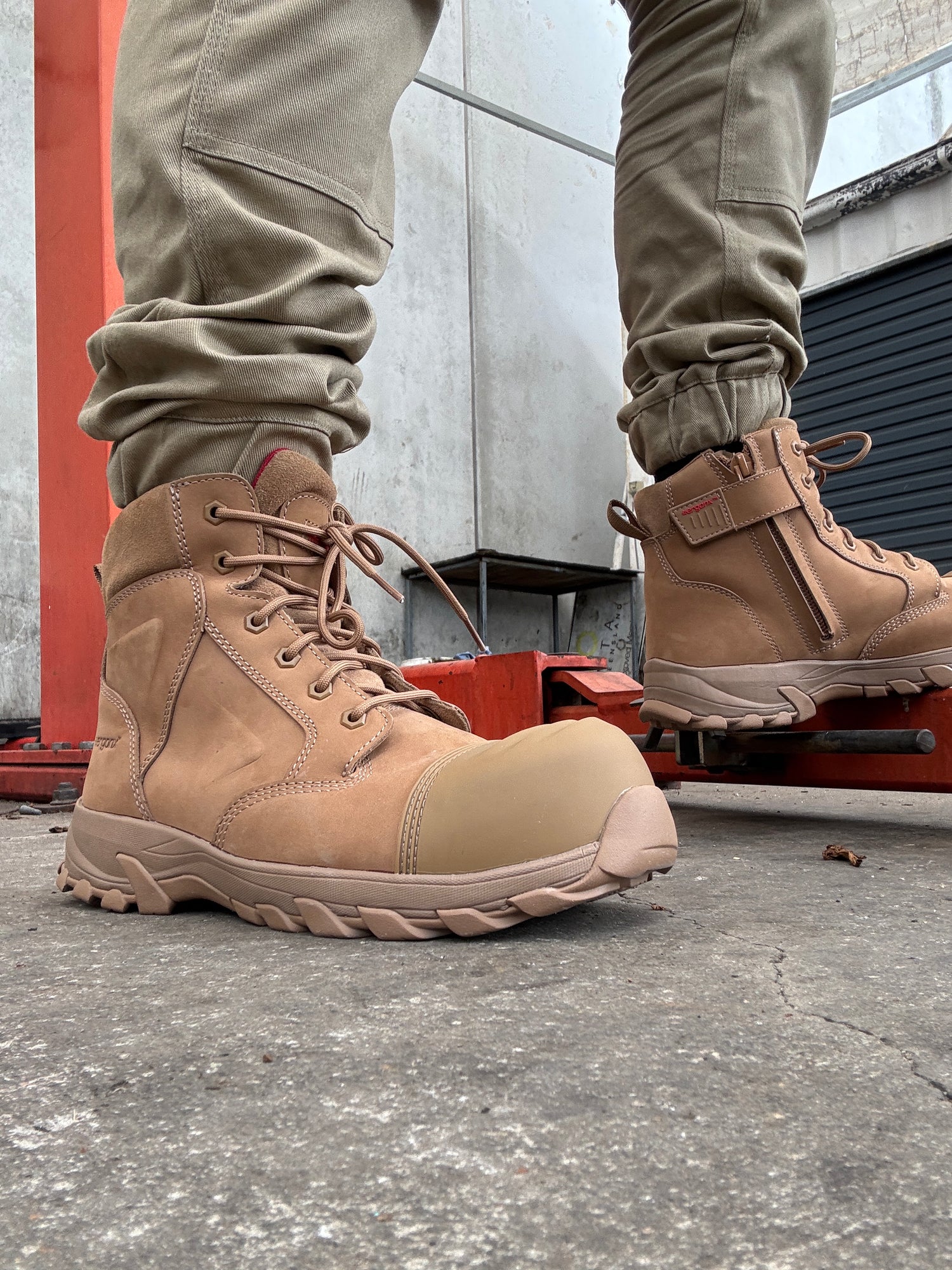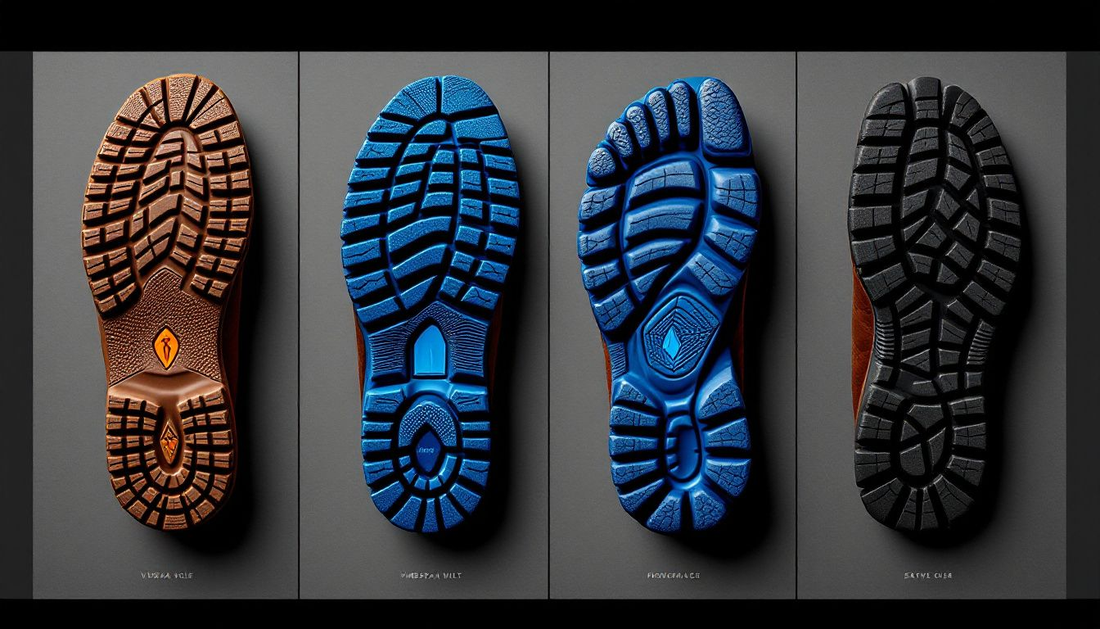Work boot soles play a crucial role in your safety and comfort on the job. Whether you’re navigating slippery surfaces or standing for hours, the right sole can make all the difference. In this article, we will explore various materials, construction methods, and advanced technologies used in work boot soles to help you decide which suits your needs best.
Key Takeaways
Work boot soles are crucial for stability, slip resistance, and overall safety, significantly influencing the comfort and performance of protective footwear.
The materials used in boot soles—rubber, polyurethane, and thermoplastic polyurethane—each provide unique benefits, catering to different work environments and ensuring durability and comfort.
Choosing the right work boot soles and maintaining them properly is essential for maximizing comfort, preventing injuries, and enhancing productivity on the job.
Understanding Work Boot Soles
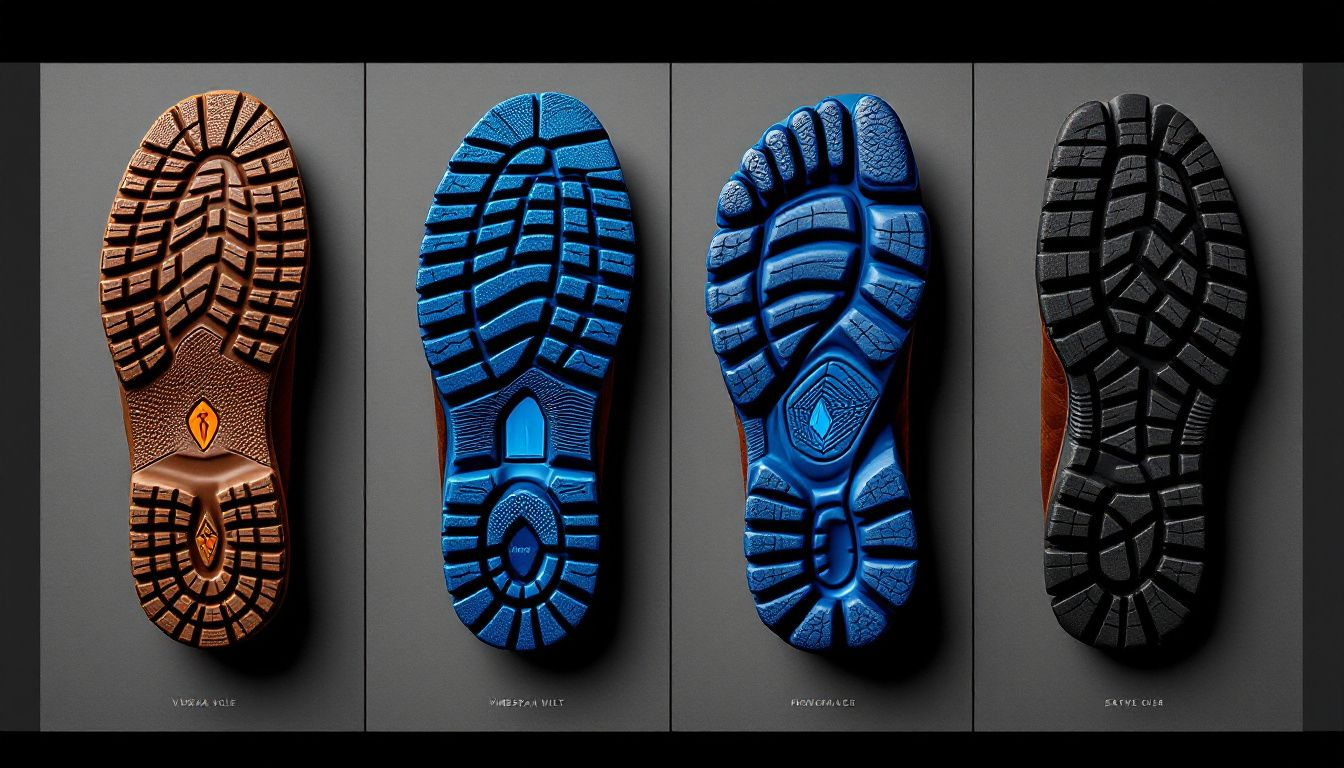 Tread pattern affects grips and trips on a workboot sole
Tread pattern affects grips and trips on a workboot sole
Work boot soles are the unsung heroes in the world of protective footwear. They provide the foundation for stability, preventing slips, trips, and falls, which are common hazards in many workplaces. High-quality work boots feature slip-resistant soles, which are crucial for maintaining safety on wet or hazardous surfaces.
The outer sole’s quality, material, tread depth, and design significantly impact the safety and well-being provided by work boots. Innovative sole technologies balance breathability, weight, and ease of use for true comfort. Knowing these elements helps you choose the best work boots for your needs.
Key Materials Used in Work Boot Soles
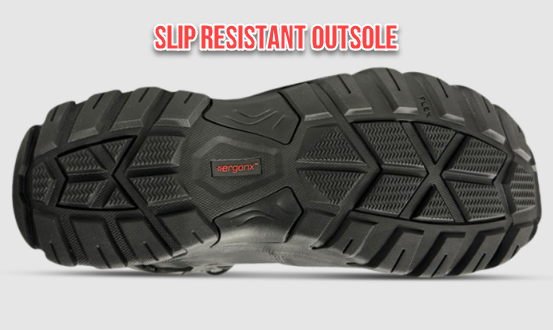 Slip resistant outsoles can help to reduce slips by up to 54% in the workplace
Slip resistant outsoles can help to reduce slips by up to 54% in the workplace
Work boot soles are crafted from various materials, each offering unique properties that cater to different work environments and demands. The most common materials include rubber, polyurethane (PU), and thermoplastic polyurethane (TPU).
Each of these materials offers distinct advantages, which are detailed below.
Rubber Soles
Rubber soles are known for their durability and resilience in demanding environments. They offer superior slip resistance, essential for worker safety across various industries. Nitrile rubber soles can withstand temperatures up to 300 degrees Celsius, making them ideal for high-temperature conditions.
Additionally, rubber soles provide excellent abrasion resistance, ensuring your boots endure rough surfaces without significant wear. This blend of durability, slip resistance, and superior resistance makes rubber soles a top choice for professionals seeking maximum comfort and performance.
Polyurethane (PU) Soles
Polyurethane (PU) soles are favored for their flexibility, lightweight nature, and excellent impact absorption. These properties make them comfortable for long hours, cushioning feet and reducing fatigue. They are also resistant to oil and fuel, adding durability in harsh conditions.
PU soles also retain flexibility at low temperatures, making them suitable for various environments. They can withstand temperatures from -30°C to 130°C, ensuring reliable performance in both extreme cold and moderate heat.
Thermoplastic Polyurethane (TPU) Soles
Thermoplastic polyurethane (TPU) soles offer different advantages. Known for exceptional abrasion resistance, they withstand significant wear, ideal for rigorous work environments. Their non-slip properties enhance safety with stronger traction on various surfaces.
The elasticity and cold resistance of TPU outsoles enhance their longevity and performance in harsh conditions. This durable versatility makes them a reliable choice for professionals facing a wide range of job challenges.
Construction Methods of Work Boot Soles
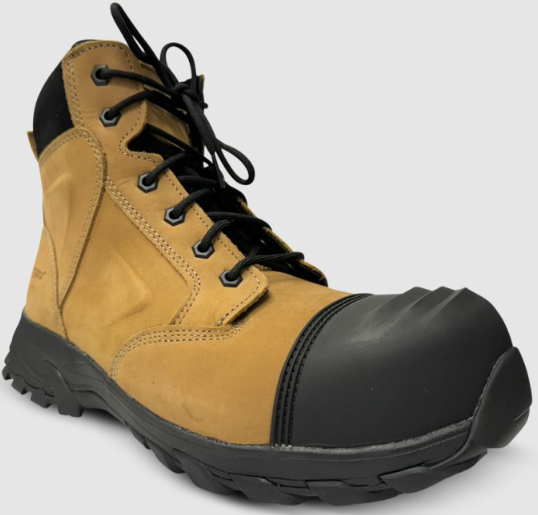 Ergonx workboots use a quality cemented construction method similar to that of high end running shoes.
Ergonx workboots use a quality cemented construction method similar to that of high end running shoes.
The construction method of work boot soles greatly affects their safety, performance, and comfort. The two main methods are glued soles and direct injection soles, each with its own advantages and potential drawbacks.
Glued Soles
Glued soles attach the sole to the boot’s upper using adhesives. This method is common but has downsides; over time, the adhesive can weaken, causing the sole to detach, compromising the boot’s integrity and posing safety hazards.
Cheaper cemented boots often fall apart quickly due to glued sole construction, making them less reliable long-term. While initially affordable, glued soles might not provide the durability needed for demanding work environments.
Direct Injection Soles
Direct injection is an advanced method where the sole is molded directly onto the upper using specialized machines. This creates an unbreakable bond, significantly enhancing durability and performance. Unlike glued soles, direct injection soles are less likely to detach over time, ensuring long-lasting reliability.
Direct injection work boots are known for superior durability, safety, and support compared to traditional methods. This construction method benefits those needing high-performance footwear for challenging work conditions.
Tread Design and Depth
Tread design and depth are critical factors in work boot sole effectiveness. Proper tread design provides excellent traction and prevents slips, while suitable tread depth ensures stability on various surfaces. Rubber outsoles, for example, offer heat resistance and excellent traction, making them ideal for challenging environments.
Rounded tread edges contribute to safer footing by reducing slipping risks. Advanced technologies like Wellmaxx optimize slip resistance on smooth industrial surfaces. The right tread pattern is essential; it should neither be too large, causing trips on carpets, nor too small, limiting slip resistance.
Deep treads are useful on irregular surfaces, providing optimal grip and stability. Self-cleaning features in tread designs prevent dirt accumulation, which can lead to accidents. Different tread designs cater to various environments: hiker-style rubber outsoles for outdoor tasks, wedge outsoles for flat surfaces in warehouses, and logger outsoles for logging work with high heels and deep treads for enhanced grip.
Advanced Sole Technologies
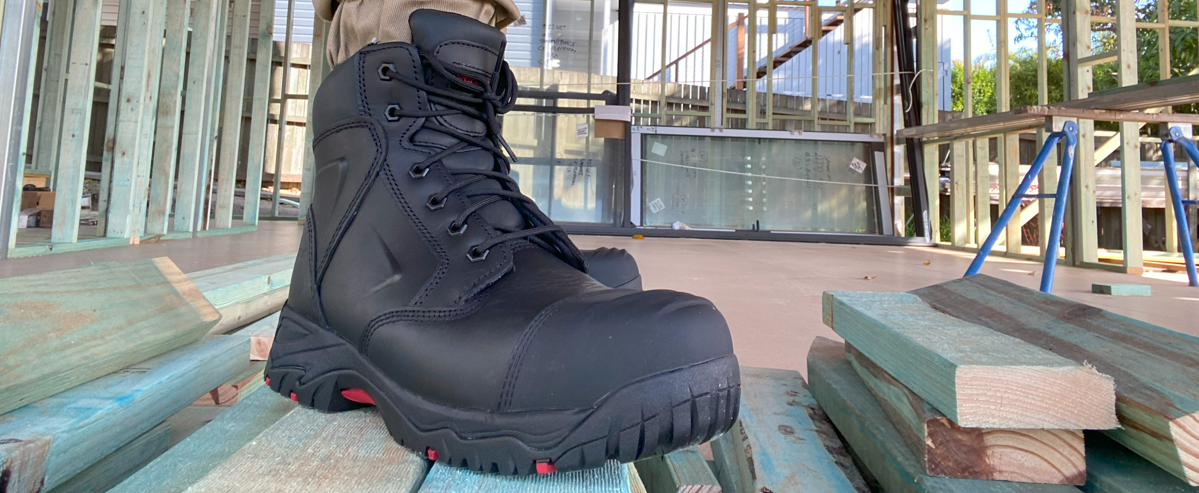 The 300 degree heat resistant outsole on the ergonx work boots is only possible using Nitrile Rubber.
The 300 degree heat resistant outsole on the ergonx work boots is only possible using Nitrile Rubber.
Advanced sole technologies have revolutionized work boot comfort and performance. For example, polyurethane soles offer thermal insulation and slip resistance while being lightweight. Direct injection provides better shock absorption, increased traction, and reduced weight, making work boots more comfortable and efficient.
These advanced technologies improve durability and user comfort, crucial for those who spend long hours on their feet in demanding environments. Consequently, work boots with these technologies can significantly enhance job performance and safety.
Choosing the Right Work Boot Sole for Your Job
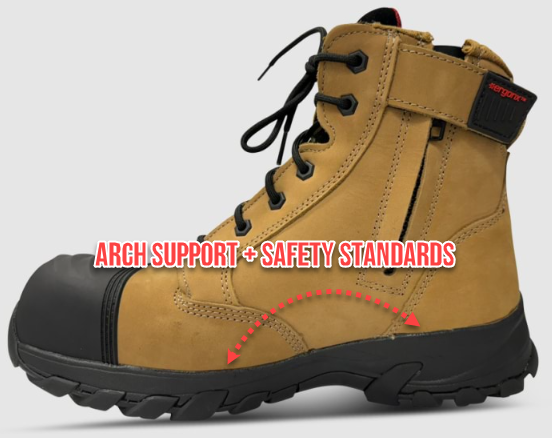 A work boots with an orthtoc insoles will be more supportive and make your feet more comfortable
A work boots with an orthtoc insoles will be more supportive and make your feet more comfortable
Choosing the right work boot sole is vital for comfort and safety on the job. Comfortable work boots directly impact your productivity, keeping you energized and effective throughout the day. A proper fit and supportive design can mitigate lower back, knee, and hip pains caused by inadequate footwear.
Consider your workplace conditions when choosing work boot soles. Tread depth provides grip on uneven surfaces and prevents accidents, while self-cleaning properties maintain optimal grip by preventing dirt accumulation. The right tread design and depth must align with your work environment for maximum safety and performance.
Maintaining Your Work Boot Soles
Maintaining work boot soles ensures their durability and performance. Regularly inspect for wear and tear to identify the need for replacement or repair before safety is compromised. Cushioning and shock-absorbing technologies in soles reduce stress on your legs and spine during demanding activities.
Proper maintenance extends your boots’ life and ensures they continue to provide necessary support and protection. Simple practices like cleaning treads and checking for cracks can significantly enhance footwear longevity.
Ergonx Arch Support Work Boots
Ergonx arch support work boots feature several advanced elements to enhance comfort and safety. Their slip-resistant outsole reduces slips and falls by up to 54%, making them reliable for various work environments. The puncture-resistant midsoles add an extra layer of safety, protecting your feet from sharp objects.
The functional tread pattern limits slip without causing trips, providing stability on various surfaces. Heat-resistant outsoles withstand temperatures up to 300 degrees Celsius, ideal for hot environments. Wearing arch support work boots supports and cushions your feet, reducing stress on muscles, joints, and ligaments.
Supporting and cushioning the foot minimizes movement, resting muscles and reducing joint grinding, helping prevent overuse injuries like plantar fasciitis and arthritis. The combination of shock-absorbing midsoles and soft arch support orthotic insoles further lowers forces on the feet, keeping them rested and pain-free.
We highly recommend Ergonx arch support podiatrist-designed work boots for their unparalleled support and comfort, making them a great pair for anyone in need of quality footwear.
Summary
In summary, the right work boot soles are essential for ensuring comfort, safety, and durability in demanding work environments. Understanding the different materials, construction methods, and tread designs can help you make an informed decision when selecting your next pair of work boots. Advanced technologies and proper maintenance further enhance the performance and longevity of your footwear.
Choosing the right work boot sole not only protects your feet but also boosts your overall job performance. Invest in high-quality work boots and experience the difference they make in your daily work life. Stay safe, comfortable, and productive with the best work boot soles available.
Frequently Asked Questions
What are the most durable materials for work boot soles?
Rubber and thermoplastic polyurethane (TPU) are the most durable materials for work boot soles, providing outstanding abrasion and slip resistance. Choosing these materials ensures longevity and safety in demanding work environments.
How often should I inspect my work boot soles?
Regular inspections of your work boot soles should occur after each use or at least once a week to maintain their condition and safety. This practice helps prevent accidents and ensures your footwear performs effectively.
What is the advantage of direct injection soles over glued soles?
Direct injection soles provide a robust and unbreakable bond with the upper, resulting in superior durability and performance compared to glued soles, which are prone to detachment over time.
Why is tread design important in work boot soles?
The tread design is vital for work boot soles as it significantly impacts traction and stability, thereby preventing slips and ensuring safety in diverse work environments.
Are Ergonx arch support work boots suitable for all work environments?
Ergonx arch support work boots are indeed suitable for various work environments due to their slip-resistant outsoles and puncture-resistant midsoles. These features enhance safety and comfort across different settings.
